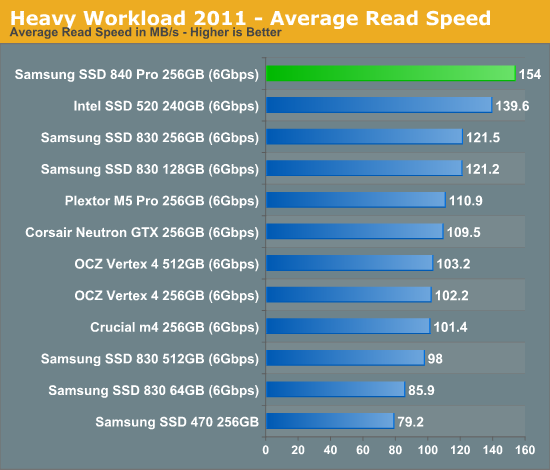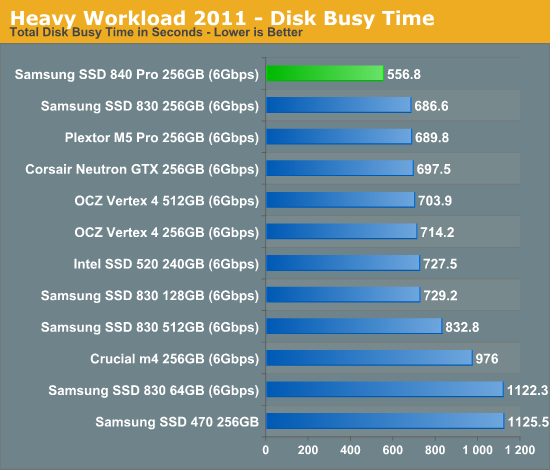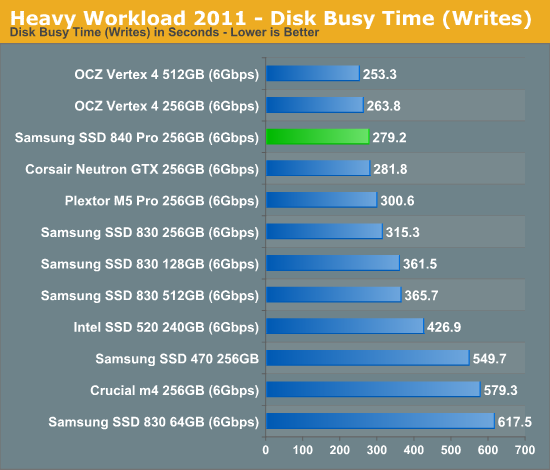Samsung SSD 840 Pro (256GB) Review
by Anand Lal Shimpi on September 24, 2012 7:00 AM EST- Posted in
- Storage
- SSDs
- Samsung
- Samsung SSD 840
AnandTech Storage Bench 2011
Two years ago we introduced our AnandTech Storage Bench, a suite of benchmarks that took traces of real OS/application usage and played them back in a repeatable manner. I assembled the traces myself out of frustration with the majority of what we have today in terms of SSD benchmarks.
Although the AnandTech Storage Bench tests did a good job of characterizing SSD performance, they weren't stressful enough. All of the tests performed less than 10GB of reads/writes and typically involved only 4GB of writes specifically. That's not even enough exceed the spare area on most SSDs. Most canned SSD benchmarks don't even come close to writing a single gigabyte of data, but that doesn't mean that simply writing 4GB is acceptable.
Originally I kept the benchmarks short enough that they wouldn't be a burden to run (~30 minutes) but long enough that they were representative of what a power user might do with their system.
Not too long ago I tweeted that I had created what I referred to as the Mother of All SSD Benchmarks (MOASB). Rather than only writing 4GB of data to the drive, this benchmark writes 106.32GB. It's the load you'd put on a drive after nearly two weeks of constant usage. And it takes a *long* time to run.
1) The MOASB, officially called AnandTech Storage Bench 2011 - Heavy Workload, mainly focuses on the times when your I/O activity is the highest. There is a lot of downloading and application installing that happens during the course of this test. My thinking was that it's during application installs, file copies, downloading and multitasking with all of this that you can really notice performance differences between drives.
2) I tried to cover as many bases as possible with the software I incorporated into this test. There's a lot of photo editing in Photoshop, HTML editing in Dreamweaver, web browsing, game playing/level loading (Starcraft II & WoW are both a part of the test) as well as general use stuff (application installing, virus scanning). I included a large amount of email downloading, document creation and editing as well. To top it all off I even use Visual Studio 2008 to build Chromium during the test.
The test has 2,168,893 read operations and 1,783,447 write operations. The IO breakdown is as follows:
| AnandTech Storage Bench 2011 - Heavy Workload IO Breakdown | ||||
| IO Size | % of Total | |||
| 4KB | 28% | |||
| 16KB | 10% | |||
| 32KB | 10% | |||
| 64KB | 4% | |||
Only 42% of all operations are sequential, the rest range from pseudo to fully random (with most falling in the pseudo-random category). Average queue depth is 4.625 IOs, with 59% of operations taking place in an IO queue of 1.
Many of you have asked for a better way to really characterize performance. Simply looking at IOPS doesn't really say much. As a result I'm going to be presenting Storage Bench 2011 data in a slightly different way. We'll have performance represented as Average MB/s, with higher numbers being better. At the same time I'll be reporting how long the SSD was busy while running this test. These disk busy graphs will show you exactly how much time was shaved off by using a faster drive vs. a slower one during the course of this test. Finally, I will also break out performance into reads, writes and combined. The reason I do this is to help balance out the fact that this test is unusually write intensive, which can often hide the benefits of a drive with good read performance.
There's also a new light workload for 2011. This is a far more reasonable, typical every day use case benchmark. Lots of web browsing, photo editing (but with a greater focus on photo consumption), video playback as well as some application installs and gaming. This test isn't nearly as write intensive as the MOASB but it's still multiple times more write intensive than what we were running in 2010.
As always I don't believe that these two benchmarks alone are enough to characterize the performance of a drive, but hopefully along with the rest of our tests they will help provide a better idea.
The testbed for Storage Bench 2011 has changed as well. We're now using a Sandy Bridge platform with full 6Gbps support for these tests.
AnandTech Storage Bench 2011 - Heavy Workload
We'll start out by looking at average data rate throughout our new heavy workload test:

A strong showing in all of our low level IO tests, with no drawbacks, results in 24% better performance than the 830 in our heavy workload. There's simply no faster drive than the 840 Pro.


The next three charts just represent the same data, but in a different manner. Instead of looking at average data rate, we're looking at how long the disk was busy for during this entire test. Note that disk busy time excludes any and all idles, this is just how long the SSD was busy doing something:













96 Comments
View All Comments
kensiko - Monday, September 24, 2012 - link
Interesting!Can Anand comment on that? Or verify it?
jb510 - Monday, September 24, 2012 - link
Same question. How do the Samsung provided numbers comparing the 830 to 840 on page 1:Active Power Use 0.24W 0.068W
Idle Power Use 0.14W 0.042W
Jive with the actual test numbers?
Guspaz - Monday, September 24, 2012 - link
I must be missing something, but on the first page, the rated power usage is:Active Power Use : 0.068W
Idle Power Use: 0.042W
While the actual measured use is 0.31W for idle and over 3W for active. That's about 50x higher, what's going on here?
btb - Monday, September 24, 2012 - link
Yeah, and no measurement of read power usage. Even though the typical user probably do an order of a magnitude more reads than writes. But thats a general anandtech testing problem, too much focus on the write specs instead of the more important read specs.ssj3gohan - Monday, September 24, 2012 - link
See my comment above here: Anandtech measures the power consumption wrongly. DIPM is not enabled, which causes ridiculously much higher power consumption.krumme - Monday, September 24, 2012 - link
The Anand hd bench was an excellent tool for comparisons, and one of the great tools Anand provided for us for delivering bm that reflected real world usage.What i derived from the first 2010 results was that the samsung disk was bad, but not so bad as it was portrayed by the reviewers and Anand. They were not worth their money, but they were slammed way to hard. At that time if we look at fx. strartup times, they were practically as fast as the fastest, so the criticism was ok, but a tad overblown.
At that time many producers was as Anand said, not focusing enough on random 4k, but i can say for sure, nothing but random 4k write was usable here at anandtech at that time too :)
sheh - Monday, September 24, 2012 - link
As usual, I'm curious about the data retention properties of drives, and how they change across a drive's lifespan as P/E cycles increase. It would be difficult to check directly, but perhaps the manufacturers can reveal the details? I also wonder if TLC will be disastrous in this regard.Kristian Vättö - Monday, September 24, 2012 - link
I asked about that in the Q&A session we had with Samsung engineers today but unsurprisingly, they couldn't tell us specific numbers. I hope to get my hands on 120GB 840 and 128GB 840 Pro to see what's the write endurance like, though that will take a while to test.FunBunny2 - Monday, September 24, 2012 - link
It looks like even the Pro has no standby cap? How can that be anything better than a toss away consumer drive?sheh - Monday, September 24, 2012 - link
They couldn't/wouldn't give numbers on P/E cycles or retention time?If you have a secret AnandTech stash of P/E exhausted drives (or could create one :), how about checksumming everything and testing every few months?